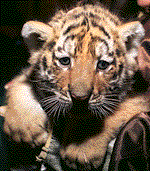

Zookeepers: professionals with a purpose
 Lincoln Park Zoo in 1868 began with
two animals and one staff member. Today the zoo employs 68 full-time professional
animal keepers who care for approximately 1,250 animals.
Lincoln Park Zoo in 1868 began with
two animals and one staff member. Today the zoo employs 68 full-time professional
animal keepers who care for approximately 1,250 animals.
Our animal caregivers devote considerable time and effort to cooperatively maintain a diverse collection of exotic and domestic animals for conservation, public education and recreation. Continually engaging in ongoing training, many keepers focus their talents on a specific group of animals such as birds of prey, great apes, elephants, or venomous snakes.
At the front lines of daily animal management, keepers also serve as on-grounds education representatives.
Daily programs such as Keeper Connection provide animal keepers the opportunity to interact with visitors, whereby teaching the public about the zoo and its role in wildlife and habitat conservation.
Many keepers also work closely with curators and other staff on various conservation and research projects at the zoo. Several animal caregivers serve on the Behavioral Enrichment Committee, a cross section of zoo staff that shares ideas and pools resources to accomplish specific animal enrichment needs. Two zookeepers on the committee recently presented papers at a national behavioral enrichment conference in Orlando, Florida.
In addition to making a difference here in Chicago, keepers have gone beyond zoo borders to participate in important international field research, which often requires travel to faraway places such as Australia and Latin America.
Although Lincoln Park's animal keepers, some of whom have devoted more than 30 years to the zoo, have backgrounds and interests as diverse as the animals in their care, they all share a common bond-a deep and genuine love for animals and a lasting commitment to preserving the world's wildlife.
On behalf of their charges, I thank them all.
Director
Lincoln Park Zoo
![]()
 Three
Siberian tiger cubs were born the week of November 17 at the Kovler
Lion House. Extremely endangered in the wild, Siberian tigers number only
about 300 in their native range. The Lincoln Park birth was recommended
by the Tiger Species Survival Plan. Mother Sheba and her new charges are
in a secluded den and will not be on exhibit until February. Blind at birth,
the cubs need plenty of time to bond with their mother and mature before
they are introduced to the public.
Three
Siberian tiger cubs were born the week of November 17 at the Kovler
Lion House. Extremely endangered in the wild, Siberian tigers number only
about 300 in their native range. The Lincoln Park birth was recommended
by the Tiger Species Survival Plan. Mother Sheba and her new charges are
in a secluded den and will not be on exhibit until February. Blind at birth,
the cubs need plenty of time to bond with their mother and mature before
they are introduced to the public.
The white-cheeked gibbons really are getting into the swing of things at their recently refurbished indoor exhibit. For more than a week Helen Brach Primate House keepers collected, sorted and selected a variety of trees, branches, crosspoles and vines that could be used to enhance the gibbons' habitat. During two days of extensive renovation everything was removed from the exhibit and replaced with the new and improved climbing elements. The gibbon pair is enjoying the new-fashioned configuration, which encourages them to spend more time in the trees and provides more space to swing.
The Regenstein Small Mammal-Reptile House recently acquired three black tree monitors. Among the most formidable of predatory lizards, these small arboreal reptiles are carnivores that eat small animals and insects. Threatened by habitat loss in its native Australia and New Guinea, the black tree monitor is not common in captivity either-fewer than 30 currently exist in just six North American zoos. The Lizard Taxon Advisory Group has recommended that zoos try to breed this species. If this new lizard trio finds love, Lincoln Park Zoo hopes to contribute to the world population of black tree monitors. Visitors can view the monitors in the Reptile Walk.
The zoo also welcomed several new feathered friends including five red-breasted geese, eight Baikal teal, eight bufflehead and six ruddy ducks. The ruddy ducks joined four others already living in the recently refurbished Hope B. McCormick Swan Pond, and the rest make their home at the new Waterfowl Lagoon. All of the birds are adapted to cold climates and will feel right at home during Chicago winters. The red-breasted geese and Baikal teal are native to northern Siberia, and the bufflehead and ruddy ducks are North American species. Lincoln Park Zoo in 1992 sent its waterfowl collection to other zoos in anticipation of the lagoon renovation and Small Mammal-Reptile House construction. The four new species, all of which are strikingly beautiful birds, were selected through the zoo's collection planning process.

